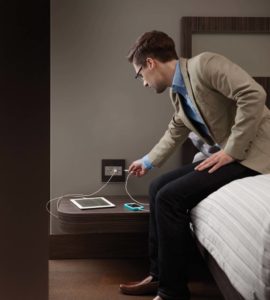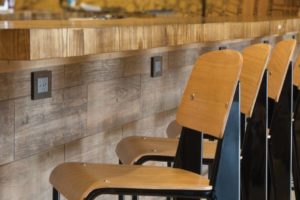Specifying electrical products for hotel properties
by Carly Midgley | August 25, 2017 10:51 am
by Nancy Snyder
 [1]
[1]All photos courtesy Legrand
Hotel guests are more technology-focused than ever before. This has created a hyper-connected travel experience, from ordering transportation to the check-in process. So what do architects and specifiers need to keep in mind when working on hospitality projects?
According to a survey[2] conducted by Expedia, 75 percent of travelers use smartphones and tablets for both personal and business reasons when traveling. Mobile devices are nearing ubiquity for business travelers across all regions and demographics, but more so for millennials than any other group, unsurprisingly.
This means travelers require convenient and easy access to power when it is needed most. Devices play a huge role in the travel experience, from research and booking to in-room services and check-in/check-out. As such, hospitality designers, owners, and operators must ensure power solutions are readily available for guests and feel seamless in the overall design. Intuitive, rather than disruptive, design is crucial.
Increase power access and connection points
There are many opportunities to improve the guest experience by helping hotel owners and developers remain ahead of power-based trends and needs. Architects, designers, and specifiers must stay in the know about the consumer technology industry and be sure to:
- offer power access via USB ports in addition to (or rather than) traditional alternating current (AC) power outlets;
- ensure multiple devices can be plugged into one source so as to save space, offer a clean aesthetic, and fully charge at the same time;
- remember each device has its own specific charging needs;
- ensure power access is flexible, universal, and accessible to accommodate unique needs without limiting others;
- avoid builder-grade power outlets and light switches and replace with chic, elevated designs;
- opt for built-in furniture options enabling power built into headboards and other areas;
- bring power/control where it is used most while eliminating extra wiring; and
- be familiar with national/local electrical codes, such as National Electric Code (NEC).
When it comes to guest rooms, architects and specifiers should see the space’s features—including the TV armoire, desks, walls, headboards, and bedside tables—as opportunities for power, charging, switching, dimming, and connectivity.
Utilize common spaces to create opportunities
In the past, hotel rooms offered in-room desks, as it was expected that people worked in their rooms. Now that rooms are growing smaller, travelers want to work in more social settings.
 [3]
[3]As hospitality businesses begin to re-evaluate the way they approach guest experiences, common spaces offer a new area of opportunity. Spaces to work, socialize, or relax outside of the guest room have become more desirable among hotel guests—especially millennial travelers[4]. In fact, 36 percent of millennials prefer to work in the lobby area, compared to 17 percent of older generations. More and more hotel lobbies are being designed as an attractive place for work with a social component, adapting to the changing needs of younger travelers. After all, what good is offering free Wi-Fi throughout a property if guests have nowhere to plug in and charge?
It is important to consider how guests will use common areas, incorporating varied seating arrangements accommodating different working styles. Integrating power access into furniture pieces or flooring treatments is also crucial. One should remember to make access easy without being a visual distraction, regardless of location.
As the lines between hotel lobbies, bars/restaurants, and business centers blur, offering solutions to multiple needs—power, food, and productivity—encourages guests to enjoy a coffee or meal while plugging in and connecting. These needs should be met throughout the property, with power and charging offered in lobby furniture, restaurants and bars, and meeting and outdoor spaces, along with additional connectivity capabilities in meeting areas.
Bring safe power outdoors
 [5]
[5]Providing power access outdoors is increasingly important, especially in seasonal or resort properties. Offering guests an opportunity to charge while relaxing outdoors—or making power for music or lighting easily accessible for event production—is a differentiation point for properties. It is important to take Mother Nature into account, ensure compliance with various codes to avoid complications, and bear in mind permanent solutions are safe solutions.
Water and electricity are never a good pair. Commonly utilized, temporary workarounds for bringing power to these spaces are either unsafe, not Underwriters Laboratories (UL)-listed for outdoor use, or temporary, causing myriad issues ranging from tripping hazards to rust and corrosion. Luckily, it is possible to deliver safe power access outdoors without interrupting carefully planned aesthetics. The simplest way to do so is to select solutions that blend seamlessly into existing landscapes. Safe, code-compliant, permanent outdoor charging access for guest use or outdoor events and entertainment reduces setup time and operational costs.
Empower guests with more control while reducing energy consumption
 [6]
[6]Per available room, U.S. hotel properties spend an average of $2196[7] on energy each year, representing about six percent of all operating costs. Across the country, energy codes are under review to reduce the amount of energy consumed by commercial properties such as hotels. By implementing products or controls to manage and increase energy efficiency onsite, hotel owners and operators can achieve cost savings that benefit the bottom line.
Keep comfort top of mind
The implementation of energy-efficient measures can improve operating costs. Designers and operators need to ensure the guest experience is not compromised, potentially reducing satisfaction and future bookings. Enhancements should be a continuation of the aesthetics offered by the property.
Systems that thoughtfully manage lights, HVAC, and power when guests enter and leave rooms create a welcome environment—lights on, perfect temperature—with the benefits of energy conservation.
Equipping rooms with dimmer lighting controls that allow guests to manage their own lighting levels—an especially welcome option with bright light-emitting diode (LED) fixtures—both reduces energy consumption and ensures guest comfort is not sacrificed. It is essential to remember:
- creating energy-efficient properties does not mean designing uncomfortable environments;
- greeting guests with smart lighting control systems that are easy and intuitive to use ensures a welcoming experience; and
- equipping guests with dimmers allows for pleasing, personalized lighting schemes.
Conclusion
Power and connectivity are crucial when specifying for hotel properties to ensure positive guest experiences. The minute guests step into a guest room, kick back in the lounge, or work up a sweat at the gym, they are seeking access to power and connectivity. Guest technology expectations are high and are only increasing, but if the teams that design, operate, and own properties seriously consider the ways in which their guests stay connected and charged, they will be able to anticipate guest needs. It is essential to create experiences that deliver unexpectedly intuitive, seamless, and delightful enhancements guests will seek out and look forward to in future visits.
 [8]Nancy Snyder is the senior manager of hospitality sales at Legrand North America. In her role, she leads market development activities and grows the sales of electrical products, lighting controls, and room management systems. Snyder establishes executive-level relationships with large hotel chains, as well as developers and owners of hotel properties and boutique brands, to transform the hospitality landscape and guest experience. She can be reached via e-mail at nancy.snyder@legrand.us.
[8]Nancy Snyder is the senior manager of hospitality sales at Legrand North America. In her role, she leads market development activities and grows the sales of electrical products, lighting controls, and room management systems. Snyder establishes executive-level relationships with large hotel chains, as well as developers and owners of hotel properties and boutique brands, to transform the hospitality landscape and guest experience. She can be reached via e-mail at nancy.snyder@legrand.us.
- [Image]: https://www.constructionspecifier.com/wp-content/uploads/2017/08/Legrand-Hospitality_Guest-Room_adorne-Furniture-Power-Center.jpg
- survey: https://viewfinder.expedia.com/features/future-of-travel-report/
- [Image]: https://www.constructionspecifier.com/wp-content/uploads/2017/08/Legrand_Hospitality_Guest-Room.jpg
- millennial travelers: http://www.hotelinteractive.com/article.aspx?articleID=28911
- [Image]: https://www.constructionspecifier.com/wp-content/uploads/2017/08/Legrand-Hospitality_Restaurant-Bar.jpg
- [Image]: https://www.constructionspecifier.com/wp-content/uploads/2017/08/Legrand-Hospitality_Outdoor-Space.jpg
- an average of $2196: https://www.energystar.gov/sites/default/files/buildings/tools/SPP%20Sales%20Flyer%20for%20Hospitality%20and%20Hotels.pdf
- [Image]: https://www.constructionspecifier.com/wp-content/uploads/2017/08/Nancy-Snyder_Legrand.jpg
Source URL: https://www.constructionspecifier.com/specifying-electrical-products-for-hotel-properties/